Kaus Australis, Epsilon Sagittarii (ε Sgr), is a binary star located in the constellation Sagittarius. With an apparent magnitude of 1.85, it is the constellation’s brightest star. It lies at a distance of 143 light years from Earth.
Kaus Australis is one of the three stars marking the Archer’s bow. It marks the southern tip of the bow, while Kaus Media marks the midpoint and Kaus Borealis, the northern tip. The three stars also form the conspicuous Teapot asterism with several other bright stars in Sagittarius: Alnasl, Ascella, Nunki, Tau Sagittarii and Phi Sagittarii.
Star system
Epsilon Sagittarii is a binary star system consisting of Epsilon Sagittarii A, a blue-white giant star, and Epsilon Sagittarii B, a star that is still on the main sequence.
Epsilon Sagittarii A has the stellar classification B9.5 III, indicating an evolved giant, bluish in colour, with a temperature of 9,960 K. The star has burned through the hydrogen supply in its core and started to expand as it evolved into a giant.
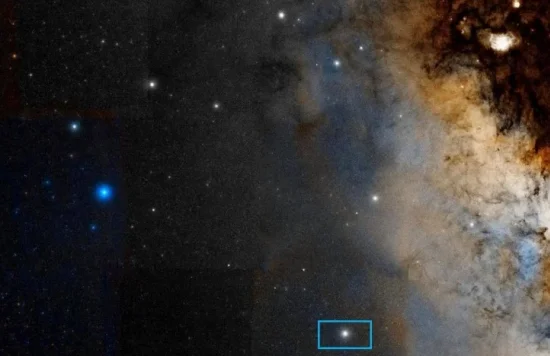
Kaus Australis (Epsilon Sagittarii), image: Wikisky
Kaus Australis has an angular diameter of 1.44 ± 0.06 milliarcseconds, which gives a physical radius about 6.8 times that of the Sun. The star has about 3.5 solar masses and shines with 363 solar luminosities.
Kaus Australis is a very fast spinner, with a projected rotational velocity of 236 km/s. It shows an excess emission of infrared radiation due to the presence of a circumstellar disk of dust. The estimated temperature of the disk indicates that it is orbiting at an average separation of 155 astronomical units from Epsilon Sagittariii A.
Epsilon Sagittarii B is separated by 2.392 arcseconds from the primary component, which equates to a physical distance of about 106 astronomical units. This places the companion within the disk of dust orbiting the star system. With a mass of 0.95 solar masses, the star is considerably less massive than Epsilon Sagittarii A.
Epsilon Sagittarii B has 89% of the Sun’s luminosity. A study published in 2001 found it to be a zero age main sequence (ZAMS) star, which is to say, a star that has only joined the main sequence by starting to burn hydrogen into helium in its core. The star’s estimated temperature is 5,807 K. Both its temperature and brightness will increase as it gets older.
There is another candidate companion separated by 32.3 arcseconds from the primary, but it is unclear whether it is physically related to the Epsilon Sagittarii system or merely appears in the same line of sight.
Facts
Kaus Australis is the 37th brightest star in the sky. It is slightly fainter than Dubhe in Ursa Major, Regor in Vela and Wezen in Canis Major, and it just outshines Ursa Major‘s Alkaid, Sargas in Scorpius and Avior in Carina.
Kaus Australis and its Teapot neighbour Nunki have been included on the list of the 58 navigational stars, which have a special status in the field of celestial navigation.
Kaus Australis has the Bayer designation Epsilon Sagittarii despite being the brightest star in Sagittarius, while Rukbat, Alpha Sagittarii (mag. 3.97) is only the 16th brightest star in the constellation. The two components of Beta Sagittarii – Arkab Prior (Beta1 Sgr, mag. 4.01) and Arkab Posterior (Beta2 Sgr, mag. 4.29) are the constellation’s 15th and 18th brightest star respectively, while Nunki, the second brightest star in Sagittarius, got the letter Sigma. The reason for this is unclear.
German uranographer Johann Bayer usually followed the rule of magnitude class when assigning Greek letter designations to stars. Even though he did not always give the brightest star the designation Alpha, he usually followed a fairly obvious logic. With the brightest stars of Ursa Major, for instance, he went from west to east, giving the constellation’s luminary, Alioth, the designation Epsilon. With Orion, he followed the magnitude class rule and went from north to south, giving the first-magnitude stars Betelgeuse and Rigel the designations Alpha and Beta, the second-magnitude Bellatrix, Mintaka, Alnilam and Alnitak the designations Gamma, Delta, Epsilon and Zeta, and so on. Sagittarius is one of the several constellations in which the order appears arbitrary.
In the 17th century, Egyptian astronomer Al Achsasi al Mouakket listed Kaus Australis as Thalath al Waridah, meaning “the third of Warida,” in his Calendarium. Warida is an asterism consisting of Kaus Australis, Kaus Media, Eta Sagittarii and Gamma Sagittarii. Its name comes from the Arabic phrase Al Naʽāma al Wārida, which means “the ostrich going down to the water.” The asterism represented one of the two groups of ostriches in Sagittarius. The other one is marked by Sigma, Phi, Zeta (Ascella), Chi and Tau Sagittarii. The stars Kaus Borealis and Polis (Mu Sagittarii) represented the ostriches’ keepers.
The Kalapalo people of Brazil saw Kaus Australis as part of an asterism called Taugi kusugu, meaning “Taugi’s fishing basket.” The other stars that formed the asterism belong to the neighbouring Scorpius constellation: Shaula, Lesath, Iota Scorpii, Sargas, Jabbah and Iklil.
Together with Kaus Media and Alnasl, Kaus Australis formed the Akkadian asterism known as Sin-nun-tu or Si-nu-nu-tum, meaning “the swallow.”
Name
The name Kaus Australis (pronunciation: /ˈkɔːs ɔːˈstrɑːlɪs /) means “the southern bow.” It is derived from the Arabic word qaws, meaning “bow” and the Latin austrālis, meaning “southern.”
The name formally applies only to Epsilon Sagittarii A. It was officially approved by the International Astronomical Union’s (IAU) Working Group on Star Names (WGSN) on July 20, 2016.
The Chinese know the star as 箕宿三 (Jī Sù sān), or the Third Star of Winnowing Basket. Winnowing Basket 箕 (Jī) is a Chinese asterism consisting of Kaus Australis, Gamma Sagittarii (Alnasl and W Sagittarii), Kaus Media and Eta Sagittarii.
The Babylonian compendium MUL.APIN lists the star as MA.GUR8, or “the Bark.”
Location
Kaus Australis is very easy to find because it is part of a relatively bright asterism known as the Teapot, which dominates the western half of Sagittarius. It is the lower right star of the Teapot and the southernmost of the three stars marking the bow of the celestial Archer.
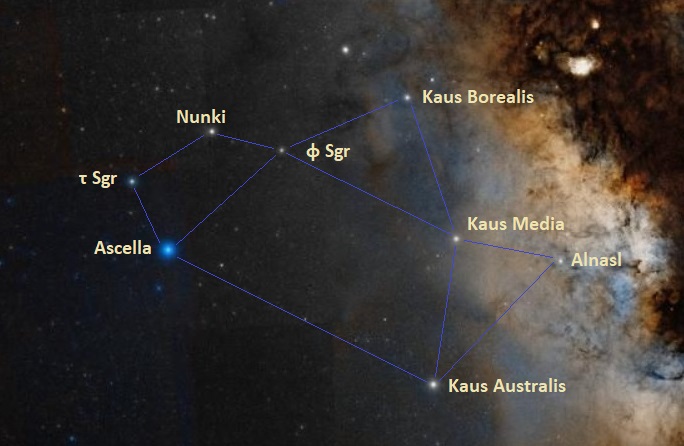
The Teapot in Sagittarius, image: Wikisky
Even though they are fairly easy to identify, the stars of Sagittarius are not visible year-round to northern observers and cannot be seen at all from far northern locations. From mid-northern latitudes, they can only be seen above the southern horizon during the summer months.
Kaus Australis forms the body of the Teapot with Ascella, Kaus Media and Phi Sagittarii and can be used to find some of the bright deep sky objects in the vicinity. There are three globular clusters located in the region between Kaus Australis and Ascella. The extragalactic cluster Messier 54 lies 1.5 degrees west and a little south of Ascella, in the direction of Kaus Australis. The globular cluster Messier 69 lies just to the north of the imaginary line connecting the stars, only 1.5 degrees from Kaus Australis, while the cluster Messier 70 lies about halfway between the two stars.
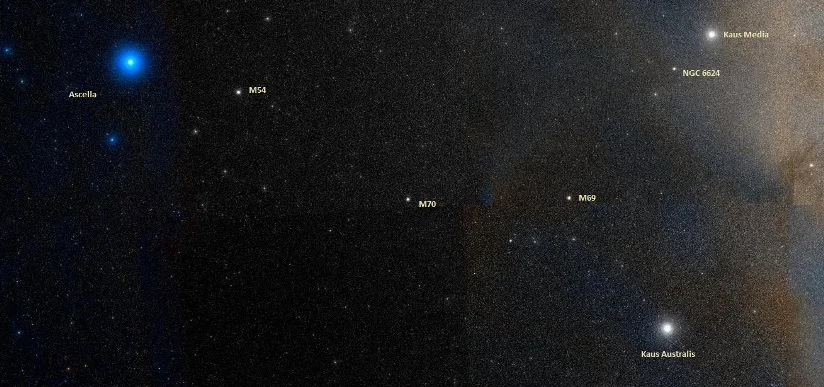
Kaus Australis, Ascella, M54, M69 and M70, image: Wikisky
An imaginary line extended from Kaus Australis to just left of Kaus Media points in the direction of two famous nebulae – the Omega Nebula (Messier 17) in Sagittarius and the Eagle Nebula (Messier 16) in the neighbouring Serpens constellation.
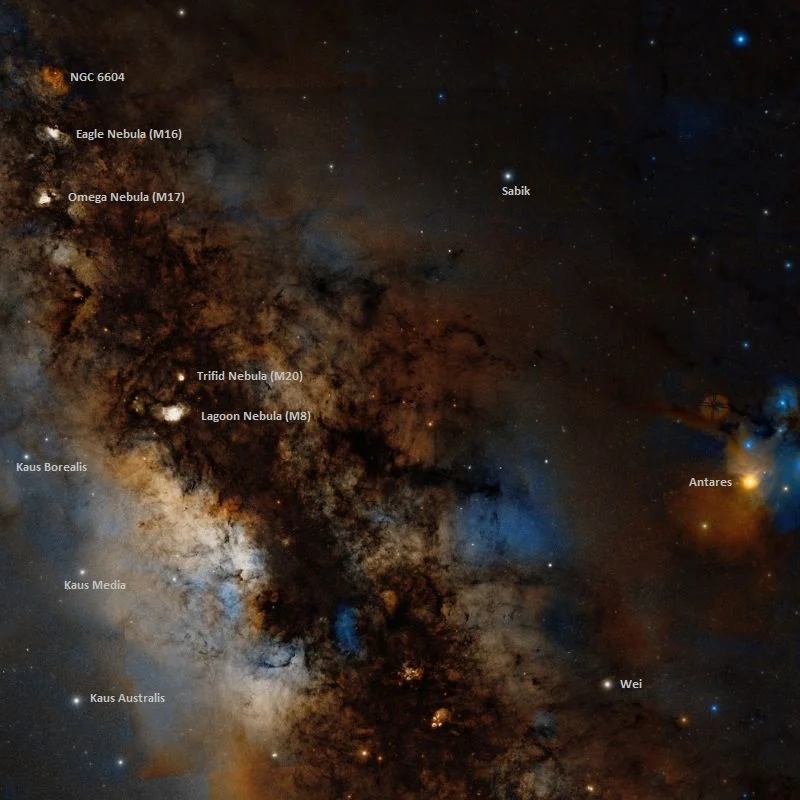
Kaus Australis, Kaus Media, the Omega Nebula and the Eagle Nebula, image: Wikisky
Constellation
Kaus Australis is located in the constellation Sagittarius, the southernmost of the zodiac constellations. Located in the direction of the centre of the Milky Way (Sagittarius A), Sagittarius lies in the densest region of the Milky Way and is home to numerous bright nebulae and star clusters. In addition to those already mentioned, the best known deep sky objects in Sagittarius include the emission nebula Messier 8 (Lagoon Nebula), the emission, reflection and dark nebula Messier 20 (Trifid Nebula), the Sagittarius Star Cloud (Messier 24), the Sagittarius Cluster (Messier 22), and the planetary nebulae NGC 6537 (Red Spider Nebula), M 1-42 (Eye of Sauron Nebula) and NGC 6445 (Little Gem Nebula).
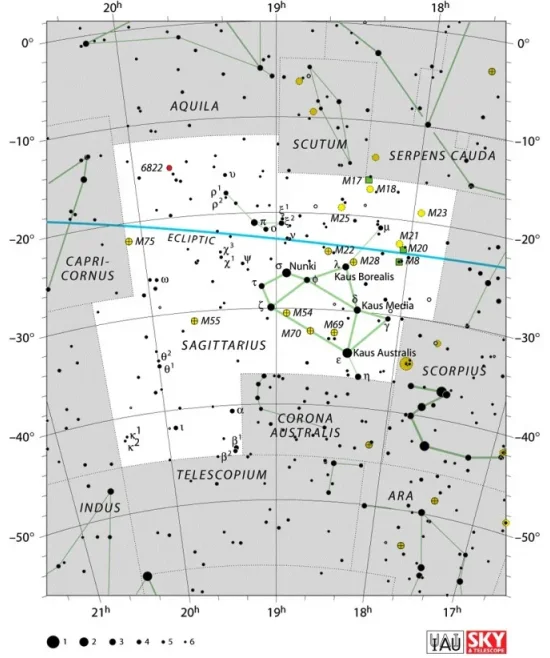
Sagittarius constellation map by IAU and Sky&Telescope magazine
The best time of year to observe the stars and deep sky objects in Sagittarius is during the month of August.
The 10 brightest stars in Sagittarius are Kaus Australis (Epsilon Sgr, mag. 1.85), Nunki (Sigma Sgr, mag. 2.05), Ascella (Zeta Sgr, mag. 2.59), Kaus Media (Delta Sgr, mag. 2.70), Kaus Borealis (Lambda Sgr, mag. 2.82), Albaldah (Pi Sgr, mag. 2.89), Alnasl (Gamma² Sgr, mag. 2.98), Eta Sagittarii (mag. 3.11), Phi Sagittarii (mag. 3.17), and Tau Sagittarii (mag. 3.326).
Kaus Australis – Epsilon Sagittarii
| Spectral class | B9.5 III |
| U-B colour index | +0.13 |
| B-V colour index | -0.03 |
| Apparent magnitude | 1.85 |
| Absolute magnitude | -1.41 |
| Distance | 143 ± 2 light years (43.9 ± 0.5 parsecs) |
| Parallax | 22.76 ± 0.24 mas |
| Radial velocity | -15 km/s |
| Proper motion | RA: -39.42 mas/yr |
| Dec.: -124.20 mas/yr | |
| Constellation | Sagittarius |
| Right ascension | 18h 24m 10.31840s |
| Declination | -34° 23’ 04.6193’’ |
| Designations | Kaus Australis, Epsilon Sagittarii, ε Sgr, 20 Sagittarii, HD 169022, HR 6879, GC 25100, HIP 90185, FK5 689, GCRV 10865, PPM 297655, SAO 210091, CCDM J18242-3423A, IDS 18175-3427 A, WDS J18242-3423AC, IRAS 18208-3424, 2MASS J18241032-3423046, TYC 7401-3471-1 |
Epsilon Sagittarii A
| Mass | 3.515 ± 0.138 M☉ |
| Luminosity | 363 L☉ |
| Radius | 6.8 R☉ |
| Temperature | 9,960 K |
| Age | 232 million years |
| Rotational velocity | 236 km/s |
| Surface gravity | 4.50 cgs |
Epsilon Sagittarii B
| Mass | 0.95 M☉ |
| Luminosity | 0.89 L☉ |
| Temperature | 5,807 K |